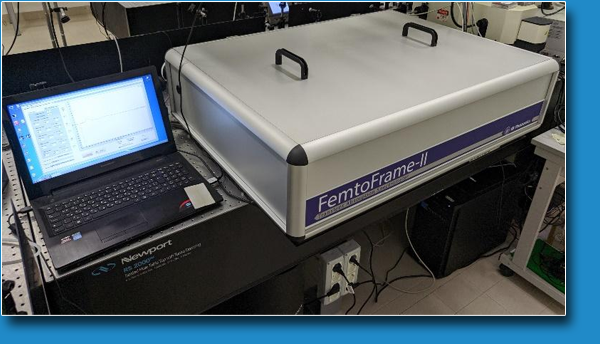
Fast Transient Absorption Spectrometer (FTAS)
EFSL - EuroFEL Support Laboratory -
TECHNICAL SPECIFICATIONS
- Rep. Rate: 1KHz
- Temporal Resolution: 50 fs
- Temporal Window: up to 1 ns
- Pump Energy Range: 240-1600 nm
- Probe Energy Range: 250-1600 nm
- Sample Temperature: RT, 77K
AVAILABLE TECHNIQUES
- FTAS in transmission
- FTAS in reflection
SAMPLE
-
Sample dimensions: 10 x 10 mm (ideal), 5 x 5 mm (minimal), 50 x 50 mm (maximal).
Sample holders are available. -
Liquid sample. Cuvettes and rotating cell are available.
Typical volume used 500 μl. -
Solid samples can be studied in transmission also at 77K
-
Time for loading the sample and start measure: 10 min at RT, 60 min at 77K
USE FOR
-
Semiconductor/ Microelectronics
-
Nanostructured materials
-
Hybrid Materials
-
Molecules and Complexes
-
Photovoltaic
-
Plasmonics
-
Photocatalysis
-
Sensors
-
Energy
-
Biophysics
Case Studies
Time-dependent optical response of three-dimensional Au nanoparticle arrays formed on silica nanowires
Transient absorption measurements on 3D Au nanoparticle (NP)-decorated SiO2 nanowire arrays. The 3D NP array has been produced by the dewetting of a thin Au film deposited on silica nanowires produced by oxidation of silicon nanowires. We demonstrate that the width of the experimental spectra, the energy shift of their position with time, and the asymmetry between the two positive wings in the dynamical variation of absorption can all be attributed to the nonuniform shape distribution of the Au NPs in the sample.
See: Phys. Rev. B, 10.1103/PhysRevB.97.115448
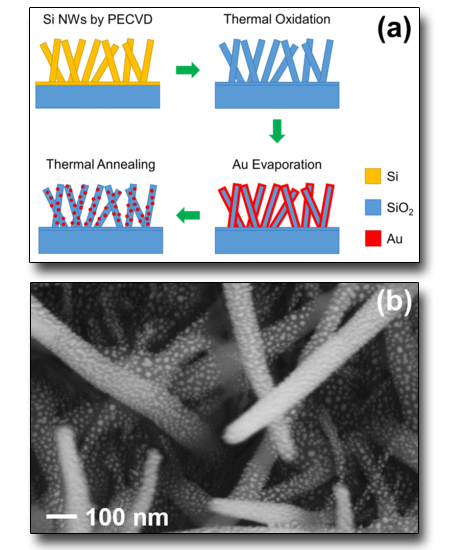
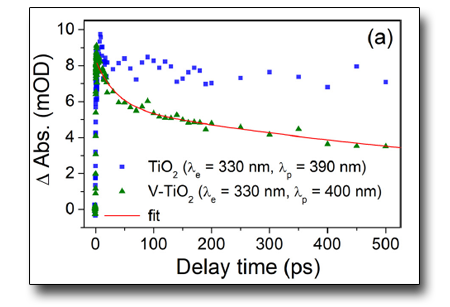
Vanadium-doped TiO2 nanoparticles (V-TiO2 NPs) with a V/Ti ratio of 3.0 at. % were prepared by gas-phase condensation and subsequent oxidation at elevated temperature. Both photocatalytic activity for -NO2 reduction and photoelectrochemical water splitting were induced by V-doping in the visible spectral range, where undoped TiO2 NPs are completely inactive. The photocatalytic properties were correlated with the ultrafast dynamics of the photoexcited charge carriers studied by femtosecond transient absorption (TA) spectroscopy with three different excitation wavelengths.
See: App. Cat. B: Env., 10.1016/j.apcatb.2018.06.011
Graphene-Induced Improvements of Perovskite Solar Cell Stability: Effects on Hot-Carriers
Hot-carriers lose their excess energy in very short times, typically in a few picoseconds after excitation. For this reason, the carrier dynamics occurring on this time scale are extremely important in determining the participation of hot-carriers in the photovoltaic process.
However, the stability of PSCs over time still remains an issue that calls for a solution. In this work, we demonstrate that the insertion of graphene flakes into the mesoscopic TiO2 scaffold leads to stable values of carrier temperature.
See: Nano Letters, 10.1021/acs.nanolett.8b03685
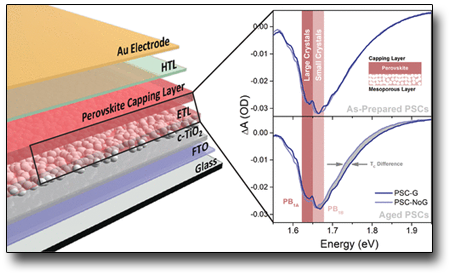
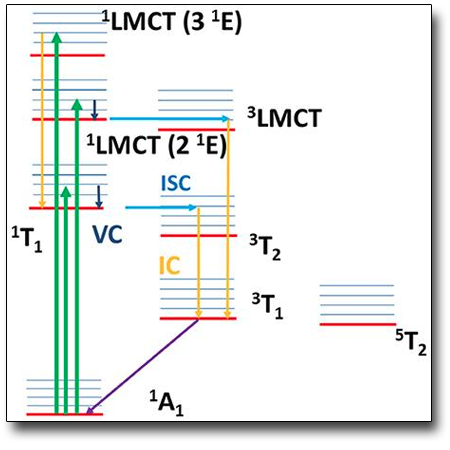
This work focuses on femtosecond transient absorption spectroscopy of Cobalt tris(acetylacetonate) (Co(AcAc)3) in solution. The fast transient absorption spectroscopy has been employed to study the excited state dynamics after optical excitation. The time resolved dynamics of the ligand to metal charge transfer excitation revealed a biphasic behavior with an ultrafast rise time of 0.07 ± 0.04 ps and a decay time of 1.5 ± 0.3 ps, while the ligand field excitation dynamics is characterized by a rise time of 0.07 ± 0.04 ps and a decay time of 1.8 ± 0.3 ps. The picosecond decay is faster than that of similar cobalt coordination complexes and is mainly assigned to internal conversion within the triplet state manifold. The lack of detectable long living states (> 5 ps), suggests that non-radiative decay plays an important role in the dynamics of these molecules.
See: Frontiers, 10.3389/fchem.2019.00348
Highly efficient plasmon-mediated electron injection into cerium oxide from embedded silver nanoparticles
The coupling with plasmonic metal nanoparticles (NPs) represents a promising route to the sensitization of wide band gap oxides to visible light. The processes which come into play after the excitation of localized surface plasmon resonances (LSPRs) in the NPs largely determine the efficiency of the charge/energy transfer from the metal NP to the oxide. High injection efficiencies in the 6–16% range have been identified for excitation between 400 and 600 nm. The information obtained provides an important contribution towards a knowledge-driven design of efficient cerium oxide based nanostructured materials for solar to chemical energy conversion.
See: Nanoscale, 10.1039/C9NR01390C
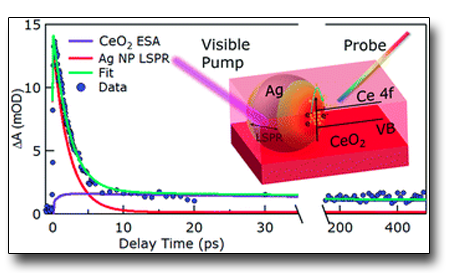

 English (UK)
English (UK)  Italiano (Italia)
Italiano (Italia)